|
|
|
Sort Order |
|
|
|
Items / Page
|
|
|
|
|
|
|
| Srl | Item |
| 1 |
ID:
110027
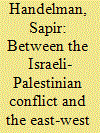

|
|
|
|
|
| Publication |
2012.
|
| Summary/Abstract |
How to create a peacemaking change in the Israeli-Palestinian struggle? The consensus solution to the Israeli-Palestinian conflict is a 'two-state solution', which means separation between two major identity groups. This paper points to the necessity to shift the emphasis in the peacemaking discussion. Instead of manufacturing solutions in a peacemaking laboratory, it would be better to focus on finding the social conditions that have the potential to create an effective peacemaking process. This paper suggests establishing a major Israeli-Palestinian public negotiating congress that has the potential to create a peacemaking revolution. The vision is based on the multi-party talks that had been conducted in Apartheid South Africa and Northern Ireland during the 'troubles' and the Minds of Peace Experiment - a small-scale Israeli-Palestinian public negotiating congress - that has been conducted in various locations around the world.
|
|
|
|
|
|
|
|
|
|
|
|
|
|
|
|
| 2 |
ID:
110030


|
|
|
|
|
| Publication |
2012.
|
| Summary/Abstract |
The article offers a critical comparison between two extreme cases of the Minds of Peace Experiment: the Detroit round (May 2009) and the first round in Israel-Palestine (Beit Jala - August 2009). It explores the question of residential location in an age of globalization as influencing reconciliation prospects in intractable disputes. Most of the participants in Detroit were Israelis and Palestinians who lived for many years in the Diaspora, while the panellists in Beit Jala reside in Israel or the West Bank. The interactions between the participants and the outcomes of the two rounds differed markedly in ways traceable to contrasting perspectives on interests and agendas. Diaspora participants tended to value issues such as justice and refugee return, while those proximate to the conflict tended to emphasize relief of everyday local grievances. The article grapples with the effects of variables such as the length of time removed from the former homeland, circumstances of departure, the degree of continued contact, and differences of political systems. It explores in essence whether and in what sense the Diaspora might play a constructive role in the struggle to bring peace and stability to the Middle East.
|
|
|
|
|
|
|
|
|
|
|
|
|
|
|
|
| 3 |
ID:
110033
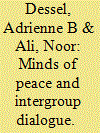

|
|
|
|
|
| Publication |
2012.
|
| Summary/Abstract |
Numerous intergroup practices have engaged Palestinians and Israelis with the hope of peacemaking and peacebuilding. As many have noted, this work has yet to achieve the desired conflict reduction and sustainable peace in the region. One important grassroots effort in building peace is a small-scale Israeli-Palestinian public negotiating assembly called the Minds of Peace Experiment. Another conflict resolution effort is intergroup dialogue, a sustained facilitated group experience designed to provide a safe space for participants to address divisive issues. This article compares and contrasts these two peacebuilding methods and how they inform each other to be used in tandem to secure a peaceful resolution to the conflict.
|
|
|
|
|
|
|
|
|
|
|
|
|
|
|
|
| 4 |
ID:
110026
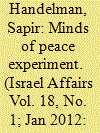

|
|
|
| 5 |
ID:
110031


|
|
|
|
|
| Publication |
2012.
|
| Summary/Abstract |
How can two peoples, engaged in a decades-long bloody conflict, break the cycle of violence, reconcile their divergent interests, and construct a reality devoid of the deep seated hatred permeating their respective communities? A novel initiative called 'The Minds of Peace Experiment' (MOPE) attempts to tackle this vexed question by bringing together regular Israelis and Palestinians to simulate the process of peace negotiations. Sitting before an audience and assisted by moderators, two mock delegations discuss the conflict and the steps they consider necessary if it is to come to a close. This article discusses the general nature of the MOPE, its stated goals, and procedure. It focuses on several significant themes that emerged from one particular instalment of the experiment. The aim is to evaluate the utility of the MOPE along two dimensions. First, in terms of its capacity to affect the dynamics of the conflict. Second, in terms of its adequacy as a model of a genuine major Palestinian-Israeli public assembly. It is argued that the MOPE is an important addition to various strategies for conflict resolution, though its effectiveness is hampered by several factors that demand attention.
|
|
|
|
|
|
|
|
|
|
|
|
|
|
|
|
| 6 |
ID:
110028
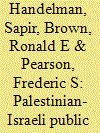

|
|
|
|
|
| Publication |
2012.
|
| Summary/Abstract |
This paper draws lessons from the role played by the black church in creating support for the US civil rights movement in relation to the struggle to involve the Palestinian and the Israeli people directly in the peacemaking efforts to resolve their tragic conflict. The civil rights struggle in both the US and South Africa eventually engaged large segments of the public in both productive debate and campaigning. The corresponding impetus now is to create a major Palestinian-Israeli public negotiating congress that can involve ordinary citizens on both sides in the peacemaking efforts. The Minds of Peace Experiment, a small-scale Palestinian-Israeli public negotiating assembly, is designed to demonstrate the peacemaking power of a subsequent major congress. The exercise, which has been conducted around the US, Canada, and the Middle East, succeeded in creating peacemaking coalitions that are based on commitment to promote the culture of peace. The question is: how can you transform this peacemaking effect into a mass movement? The American black church movement as well as the South African mass mobilization can offer important indications of effective strategy.
|
|
|
|
|
|
|
|
|
|
|
|
|
|
|
|
| 7 |
ID:
110034
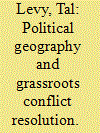

|
|
|
|
|
| Publication |
2012.
|
| Summary/Abstract |
The Israeli-Palestinian conflict is well known and understood within the intricacies and intractability that it possesses. The political geography of the region known as the Holy Land has been debated by elites since before the establishment of the state of Israel. Demographic realities have altered the geopolitical definitions of what is defined as Israel and Palestine. Currently, there is a fresh push by political elites to achieve new political resolutions that will respect the aspirations of both the Israelis and Palestinians. This process has been bogged down by new demographic realities specifically in the West Bank. An alternative mode of negotiations known as the 'Minds of Peace' experiment or MOPE uses a grassroots approach to try the overcome stumbling blocks in the current Israeli-Palestinian peace process. The MOPE experiment provided fresh and valuable perspectives on the conflict. This article discusses reflections of the author on this new and innovative approach to peacemaking.
|
|
|
|
|
|
|
|
|
|
|
|
|
|
|
|
| 8 |
ID:
110032
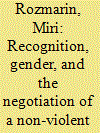

|
|
|
|
|
| Publication |
2012.
|
| Summary/Abstract |
This article examines two factors, recognition and gender, which, it is argued, need to be integrated with the MOP (Mind of Peace) model. The first section of the paper elaborates on the demand for recognition as both intersubjective and collective demand. It employs examples from one of the experiments, which took place in Beit Jala, in order to suggest how the MOP experiment might deal with these two facets of recognition. The second section of the article argues that a gendered perspective could contribute to the success of the MOP experiment. By implementing the logic of the 1325 UN Security Council resolution, and feminist scholarship, it suggests what such a gendered perspective might mean for the MOP experiment.
|
|
|
|
|
|
|
|
|
|
|
|
|
|
|
|
| 9 |
ID:
110029


|
|
|
|
|
| Publication |
2012.
|
| Summary/Abstract |
This article draws on research from social marketing, psychology, and public opinion to suggest a strategic communications planning process appropriate to this context. It is organized around a case study of Brit Tzedek v'Shalom, an American Jewish organization that successfully built a grassroots movement in support of a negotiated two-state solution. Consistent with a social marketing approach, the case study illustrates how (a) an audience (in this case the American Jewish community) can be described in terms of political opinion segments, (b) how an organization can select one or more of these segments to focus on, and (c) how a tool called the five-box positioning statement can be used to craft a core message for the organization. Part (a) of this case study includes a description of opinion segments within the American Jewish community. This description is based on polling data combined with seven years of semi-formal ethnographic research by the author. Finally, the implications of this case study for the Minds of Peace Experiment are explored.
|
|
|
|
|
|
|
|
|
|
|
|
|
|
|
|
|
|
|
|
|